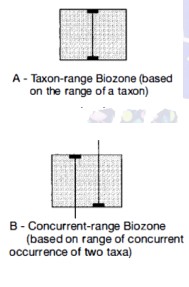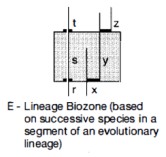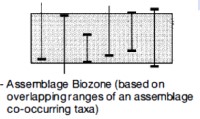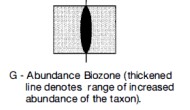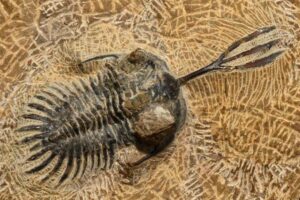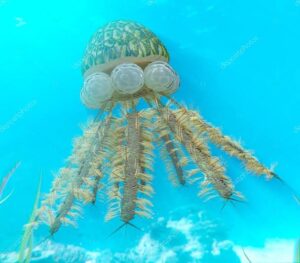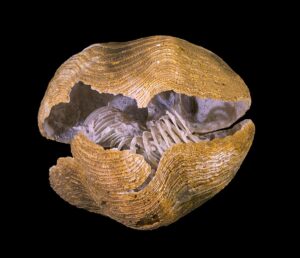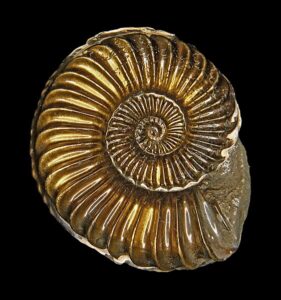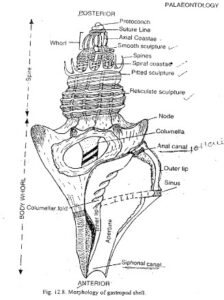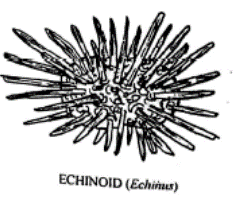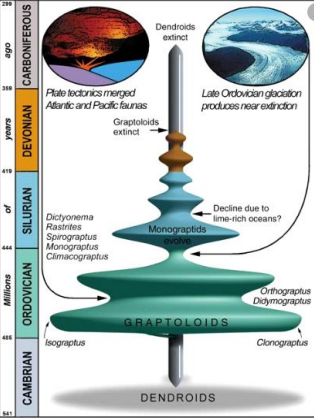The characterization and correlation of rock units on the basis of their fossil content is called biostratigraphy. It is fundamentally different from a lithostratigraphic unit that is defined by the lithological properties of the rock. The concept of biostratigraphy is based on the principle that organisms have undergone successive changes throughout geologic time. Thus, any unit of strata can be dated and characterized by its fossil content. That is, on the basis of its contained fossils, any stratigraphic unit can be differentiated from stratigraphically younger and older units.
What is the purpose of biostratigraphy?
- Differentiation of Strata
- Correlation
- Interpretation of Earth History
- Evolutionary Biology
What is the taxonomic system of classification of organisms?
- Genus: A genus (plural genera) is a group of species that are closely related. When an organism is named, it is given a genus as well as a species; for example, Homo.
- Species: The smallest unit of Taxonomic Classification. In Biostratigraphy, paleontologists are more concerned with species for correlation.
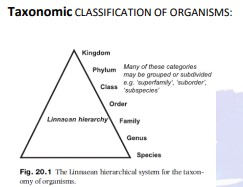
Fossils as a Basis for Stratigraphic Subdivision
What is the principle of faunal succession?
- Discovered by William Smith and G. Cuvier in the 1800s, they found that fossil-bearing strata occur in a definite and determinable order.
- Based on Smith’s discovery, rocks formed during any particular interval of geologic time can be recognized and distinguished by their fossil content from rocks formed during other time intervals.
- This concept is known as the principle (law) of faunal succession.
- Distinct faunas succeed one another regularly in the rocks, from simpler types in older rocks to more complex types in younger rocks.
- This principle is the cornerstone of Biostratigraphy.
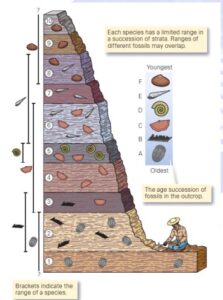
What do you mean by fossils?
- The word fossil in Latin means ‘anything dug up’ or extracted from the earth.
- A precise definition of a fossil: An actual remain or indirect evidence of prehistoric life preserved within a rock under natural conditions.
- Criteria for identifying fossils:
- The object must have some relation to an organism, either directly or indirectly. No structure produced by an inorganic process should be called a fossil.
- The related organism must be prehistoric, meaning it existed before the history of modern man, who appeared about 40,000 years ago.
- Example: The mummy of Egypt is not a fossil.
What are the main types of fossils?
- Type of Organism: Animal or Plant
- Size: Mega/Macro or Microfossils
- Imprints Fossils
- Moulds Fossils
- Trace Fossils / Ichnofossils
- Direct Fossils
- Indirect Fossils
Fossil Use in Biostratigraphy
- Fossils are used in the biostratigraphic classification of sedimentary rocks as they change with time, i.e., in a vertical direction due to organic evolution.
What is an Ideal Zone Fossil/Index Fossil ?
- Sedimentary rock in which they occur may be subdivided into a number of zones depending on the disappearance of older forms and the appearance of newer organisms.
- An ideal zone fossil would be an organism that lived in all depositional environments worldwide, was abundant, had easily preserved hard parts, and was part of an evolutionary lineage that frequently developed new, distinct species.
- Index Fossil (Index Species, Zone Fossil): A fossil whose presence is chosen to denote the zone in which it occurs and after which the zone is named. Index fossils are selected for their distinctiveness and/or abundance. To be of use in biostratigraphy, ideally, an index fossil should have a narrow range in time (i.e., have undergone rapid evolutionary change) but have had a wide geographical distribution.
- Trilobites: Cambrian
- Graptolites: Ordovician and Silurian
- Ammonites: Jurassic
- Foraminifera: Cretaceous and Cenozoic
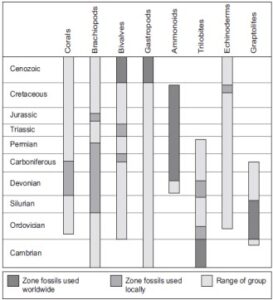
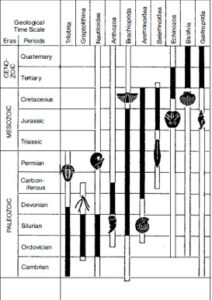
The white columns show the period of distribution, and the black columns the period in which the organisms are important as index fossils.
Concept of Stage
Smith’s faunal succession law was the cornerstone for biostratigraphy, but his work was vague. In 1833, Lyell in England and others proposed subdivisions of Tertiary strata based on fossils. Lyell’s subdivisions are historically noteworthy. He split the Tertiary strata into four units on the basis of the proportions of living to extinct species in the rocks. This was the first time fossils were used as an essential part of the definition of units of geologic time, allowing for biostratigraphy to be independent of lithologic control.
In 1842, Alcide d’Orbigny introduced the concept of stage. He proposed major subdivisions of strata, each systematically following the other and each bearing a unique assemblage of fossils. Stages are groups of strata containing the same major fossil groups.
Lylle’s Subdivision of Tertiary
| Name of subdivision | Extant species in the rocks (%) |
| Pliocene (more recent) | |
| Newer Pliocene | 90 |
| Older Pliocene | 33–50 |
| Miocene (less recent) | 18 |
| Eocene (dawn of recent) | 3.5 |
Concept of Zone
The stage concept of d’Orbigny permitted the subdivision of strata into major successions based on fossils. However, it did not provide a method for dividing fossiliferous strata into smaller, clearly delimited units. In 1856, Albert Oppel introduced the concept of zone. He conceived the idea of small-scale units defined by the stratigraphic ranges of fossil species, irrespective of the lithology of the fossil-bearing beds. Each of Oppel’s zones was named after a particular distinctive fossil species, called an index fossil, or index species, which is but one fossil species in the assemblage of species that characterize the zone. This concept allowed the subdivision of stages into two or more smaller, distinctive biostratigraphic units that could be recognized and correlated over long distances.
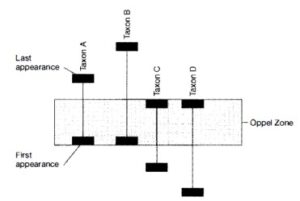
What are the basic units of biostratigraphy?
A biostratigraphic unit is a body of rock defined by its fossil content. It is a body of rock strata characterized by its fossil content that distinguishes and differentiates it from adjacent strata. This is fundamentally different from a lithostratigraphic unit, which is defined by the lithological properties of the rock. Biozones do not have any prescribed thickness or geographic extent.
Categories and ranks of stratigraphic units as defined in North American Commission on Stratigraphic Nomenclature Note 63
| Lithostratigraphic | Lithodemic | Magnetopolarity | Biostratigraphic | Pedostratigraphic | Allostratigraphic |
| Supergroup | Supersuite | Polarity Superzone | Biozone (Interval, Assemblage or Abundance) | Geosol | Allogroup |
| Group | Suite | Polarity Zone | Subbiozone | Alloformation | |
| Formation | Lithodeme | Allomember | |||
| Member (or Lens, or Tongue) | Complex | Polarity Subzone | |||
| Bed(s) (or Flow(s)) |
Biozone
The fundamental unit of biostratigraphy is the Biozone. Biozones are units of stratigraphy that are defined by the zone fossils/index fossils (usually species or subspecies) that they contain.
What are the different types of biozones?
According to the North American Stratigraphic Commission Note 64, biostratigraphic units are subdivided into five principal kinds of biozones:
Range Biozones (Two kinds):
- Taxon-range biozone: A body of rock representing the known stratigraphic and geographic range of occurrence of a single taxon.
- Concurrent range biozone: A body of rock that includes the concurrent, coincident, or overlapping part of the ranges of two specified taxa.

Interval Biozones (Two or more kinds):
- Interval biozone: The body of strata between two specific biostratigraphic surfaces. These surfaces are commonly based on the lowest and highest occurrences of taxa, but may also include distinctive occurrences and changes in the character of individual taxa, such as changes in the direction of coiling in foraminifers or in the number of septa in corals.
- Partial range biozone: Based on two taxa that do not have overlapping ranges; the base is defined by the disappearance of one taxon and the top by the appearance of a second. (Note: In Gary Nichols’ “Sedimentology” book, the definition of partial range zone is given oppositely.)

Lineage Biozone/Consecutive Biozone:
- A body of rock containing species representing a specific segment of an evolutionary lineage.

- A body of rock containing species representing a specific segment of an evolutionary lineage.
Assemblage Biozone:
- A body of rock characterized by a unique association of three or more taxa, the association of which distinguishes it in biogeographic character from adjacent strata. An assemblage biozone may be based on a single taxonomic group, such as trilobites, or on more than one group, such as acritarchs and chitinozoans.

- A body of rock characterized by a unique association of three or more taxa, the association of which distinguishes it in biogeographic character from adjacent strata. An assemblage biozone may be based on a single taxonomic group, such as trilobites, or on more than one group, such as acritarchs and chitinozoans.
Abundance Biozone:
- A body of rock in which the abundance of a particular taxon or specified group of taxa is significantly greater than in adjacent parts of the section. Also known as an Acme Zone.

- A body of rock in which the abundance of a particular taxon or specified group of taxa is significantly greater than in adjacent parts of the section. Also known as an Acme Zone.
Naming Biostratigraphic Units
The name of a biozone consists of the name of one or more distinctive taxa found in the biozone, followed by the word “Biozone” (e.g., Turborotalia cerrozaulensis Biozone, a Foraminifera). The name of the species whose lowest occurrence defines the base of the zone is the most common choice for the biozone name.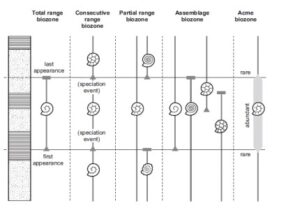
Biocorrelation
Biostratigraphic units are observable, objective stratigraphic units identified on the basis of their fossil content. As such, they can be traced and matched from one locality to another just as lithostratigraphic units are traced. Biostratigraphic units may or may not have time significance. For example, assemblage biozones and abundance biozones may cross time lines (be diachronous) when traced laterally.
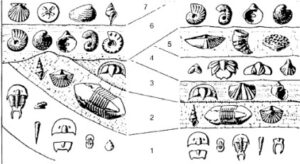
Correlation by Acme/abundance Zone:

Correlation between two hypothetical sections based on taxon-range and interval biozones illustrates this principle. For example, Zone 1 is defined by the total vertical range of Species A (taxon-range zone); Zone 2 is an interval zone defined by the last appearance of Species A and the first appearance of Species B; Zone 4 is formed by the overlapping ranges of Species B and C; and so forth. 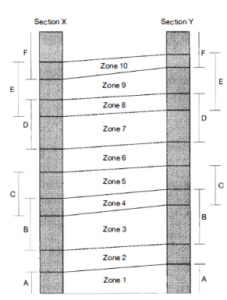
Taxa/Fossils Used in Biostratigraphy
No single group of organisms fulfills all the criteria for the ideal zone fossil, and a number of different groups of taxa have been used for defining biozones through the stratigraphic record.
Ideal Zone Fossil
The ideal zone fossil would be an organism that lived in all depositional environments all over the world and was abundant. It would have easily preserved hard parts and would be part of an evolutionary lineage that frequently developed new, distinct species.
Marine Macrofossils
The fossils of organisms such as molluscs, arthropods, echinoderms, etc., are relatively easy to identify in hand specimens and provide the field geologist with a means for establishing the age of rocks to the right period or possibly epoch.
- Trilobites: These Paleozoic arthropods are the main group used in the zonation of the Cambrian. Most trilobites are considered benthic forms living on and in the sediment of shallow marine waters. They show various morphologies and appear to have evolved quite rapidly into taxa with distinct and recognizable characteristics. They are only locally abundant as fossils.

- Graptolites: These exotic and somewhat enigmatic organisms are interpreted as being colonial groups of individuals connected by a skeletal structure. They appear to have had a planktonic habit and are widespread in Ordovician and Silurian mudrocks.

- Brachiopods: Shelly, sessile organisms such as brachiopods generally make poor zone fossils, but in shallow marine, high-energy environments where graptolites were not preserved, brachiopods are used for regional correlation purposes in Silurian rocks and in later Paleozoic strata.

- Ammonoids: This taxonomic group of cephalopods (phylum Mollusca) includes goniatites from Paleozoic rocks as well as the more familiar ammonites of the Mesozoic. The large size and free-swimming habit of these cephalopods made them an excellent group for biostratigraphic purposes. Fossils are widespread, found in many fully marine environments, and they are relatively robust. Morphological changes through time were to the external shape of the organisms and to the suture line, the relic of the bounding walls between the chambers of the coiled cephalopod. Goniatites have been used in correlation of Devonian and Carboniferous rocks, whereas ammonites and other ammonoids are the main zone fossils in Mesozoic rocks. Ammonoids became extinct at the end of the Cretaceous.

- Gastropods: These also belong to the Mollusca, and as marine snails, they are abundant as fossils in Cenozoic rocks. They are very common in the deposits of almost all shallow marine environments. Distinctive shapes and ornamentation on the calcareous shells make identification relatively straightforward, and there are a wide variety of taxa within this group.

- Echinoderms: This phylum includes crinoids (sea lilies) and echinoids (sea urchins). Most crinoids probably lived attached to the substrate, and this sessile characteristic makes them rather poor zone fossils, despite their abundance in some Paleozoic limestones. Echinoids are benthic, living on or in soft sediment. Their relatively robust form and subtle but distinctive changes in their morphology have made them useful for regional and worldwide correlation in parts of the Cretaceous.

- Corals: The extensive outcrops of shallow marine limestones in Devonian and Lower Carboniferous (Mississippian) rocks in some parts of the world contain abundant corals.
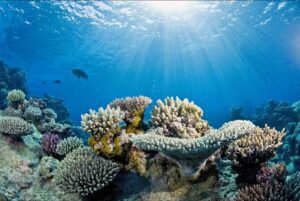
Microfossils
Microfossils are taxa that leave fossil remains that are too small to be clearly seen with the naked eye or hand lens. They are normally examined using an optical microscope, although some forms can be analyzed in detail only using a scanning electron microscope. The three main groups that are used in biostratigraphy are the foraminifers, radiolaria, and calcareous algae (nanofossils). Other microfossils used in biostratigraphy are ostracods, diatoms, and conodonts.
- Foraminifera: “Forams” (the common abbreviation of foraminifers) are single-celled marine organisms that belong to the Protozoa Subkingdom. They first appeared in the Cambrian. Forms with hard calcareous shells, or tests, became well established in the Devonian. Calcareous forams generally became more abundant through the Phanerozoic and are abundant in many Mesozoic and Cenozoic marine strata. Planktonic forams make very good zone fossils as they are abundant, widespread in marine strata, and appear to have evolved rapidly. Schemes using forams for correlation in the Mesozoic and Cenozoic are widely used in the hydrocarbon industry because microfossils are readily recovered from boreholes, and both regional and worldwide zonation schemes are used.
- Radiolaria: These organisms form a subclass of planktonic protozoans and are found as fossils in deep marine strata throughout the Phanerozoic. Radiolaria commonly have silica skeletons and are roughly spherical, often spiny organisms less than a millimeter across. They are important in the dating of deep-marine deposits because the skeletons survive in siliceous oozes deposited at depths below the CCD. Their stratigraphic range is also greater than the forams, making them important for the dating of Paleozoic strata.
Other Microfossils
- Ostracods: These are the most common arthropods of the fossil record. Zonation using ostracods is applied only locally in both marine and non-marine environments.
- Diatoms
- Conodonts: Paleozoic (Devonian)
- Cocolithophores: Mesozoic to Cenozoic
- Acritarchs: These are microscopic spiny structures made of organic material that occur in Proterozoic and Paleozoic rocks. Their occurrences in Precambrian strata make them useful as a biostratigraphic tool in rocks of this age.
FAQs
What are the principles of biostratigraphy?
Biostratigraphy is based on the principles of fossil succession, where fossils appear in a specific and predictable order. The key principles include:
Fossil Assemblage: Groups of fossils that occur together in rock layers.
Index Fossils: Fossils of organisms that lived for a short period but were widespread.
Correlation: Matching rock layers based on fossil content.
What is an example of biostratigraphy?
An example of biostratigraphy is the use of Ammonoids, shelled cephalopods that evolved quickly, making them valuable for dating rock layers
What are the examples of stratigraphic principles?
The principles include:
Superposition: Younger rocks are on top of older rocks.
Original Horizontality: Sedimentary rocks are deposited in horizontal layers.
Lateral Continuity: Layers extend laterally until they thin out or meet a barrier.
Cross-cutting Relationships: Features cutting through layers are younger than the layers themselves.
Inclusions: Fragments within a rock are older than the rock itself.
What type of rock is mostly used in chronostratigraphy?
Igneous rocks are commonly used because they can be dated using isotopic methods and provide precise geologic time markers.
What are some criteria that make a fossil a good index fossil?
A good index fossil must be:
Distinctive and easily recognizable.
Abundant in the rock record.
Widespread geographically.
Limited to a short geological time span.
What taxa are used in biostratigraphy?
The main groups used in biostratigraphy include:
Foraminifers
Radiolaria
Calcareous algae (nanofossils)
Ostracods, diatoms, and conodonts
What are the 7 laws of stratigraphy?
The seven fundamental stratigraphic principles include:
Superposition
Original Horizontality
Lateral Continuity
Cross-cutting Relationships
Inclusions
Unconformities
Fossil Succession
How do scientists use fossils to understand geological time?
Scientists study sedimentary rock layers and fossils to determine past events. They use:
The Law of Superposition to find relative ages.
The Law of Cross-cutting Relationships to establish the sequence of events.
Index fossils to correlate layers across different regions.
Which layer of rock is the youngest?
The youngest rock layer is usually the topmost sedimentary layer in an undisturbed sequence. If igneous, the youngest is the most recently formed.
What is the principle of biostratigraphic correlation?
It is the correlation of rock layers using index fossils. Index fossils define specific geologic time intervals, allowing scientists to match layers across vast regions.
What are the principles of spectrometry?
Spectrophotometry measures the absorption or transmission of light through a substance. The core principle states that each compound absorbs/transmits light at specific wavelengths.
What are the principles of bioregionalism?
Bioregionalism emphasizes living sustainably within a region by maintaining biodiversity, soil health, clean water, and air quality.
What are the principles of Prägnanz design?
The Principle of Prägnanz, from Gestalt psychology, states that humans perceive complex images in the simplest form possible, aiding clarity in design.
Is biostratigraphy still used?
Yes, biostratigraphy remains essential for dating rock layers, especially in petroleum exploration and paleontology.
What is a bad index fossil?
A bad index fossil is one that is rare, poorly preserved, or not widely distributed. For example, birds do not make good index fossils due to their delicate bones.
What organisms are commonly used in biostratigraphy?
Common organisms include diatoms, foraminifera, radiolaria, ostracods, conodonts, and ammonites.
What are 3 good index fossils?
Three commonly used index fossils are:
Ammonites (Mesozoic era)
Brachiopods
Trilobites (Paleozoic era)
What is superposition in geology?
The Principle of Superposition states that in a sequence of undisturbed sedimentary rocks, the oldest layer is at the bottom, and the youngest is at the top.
Which type of fossil is the oldest?
Stromatolites are the oldest known fossils, dating back to 3.5 billion years ago.
Who is the father of stratigraphy?
Who is the father of stratigraphy?
What is intrusive archaeology?
Intrusive archaeology refers to digging techniques that disturb underlying strata, often necessary in rescue surveys.
What does lithology mean in geology?
Lithology refers to the physical characteristics of rocks, including their composition, texture, and color.
What is the difference between biostratigraphy and stratigraphy?
Biostratigraphy focuses on fossil-based dating, while stratigraphy studies rock layering and formation processes.
How are index fossils used in biostratigraphy?
Index fossils help correlate rock layers and determine their relative ages by identifying species that lived in specific geological periods.
Is biostratigraphy absolute dating?
No, biostratigraphy is a relative dating method that arranges rock layers in chronological order based on fossil content.
What do geologists use index fossils for?
Index fossils help determine rock ages and correlate layers across different locations.
What types of rocks are used for stratigraphic studies?
Stratigraphic studies primarily focus on sedimentary and layered volcanic rocks.
What are FADs and LADs?
FADs (First Appearance Datums) and LADs (Last Appearance Datums) mark the first and last occurrences of a fossil species in the rock record.
What is lithostratigraphy in geology?
Lithostratigraphy classifies rock layers based on observable lithological properties and their relative positions.
What types of fossils do not qualify as index fossils?
Fossils of rare or long-lived species, like primates, are not ideal index fossils.
What is the order of superposition?
It states that the oldest layer is at the base, and the youngest is at the top in an undisturbed sequence.

